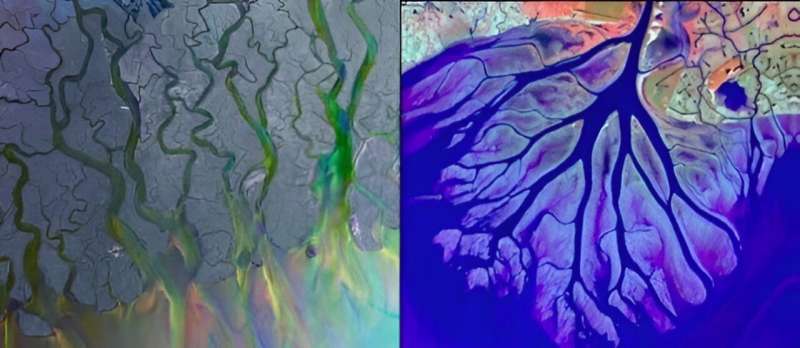This article has been reviewed according to Science X's editorial process and policies. Editors have highlighted the following attributes while ensuring the content's credibility:
fact-checked
peer-reviewed publication
trusted source
proofread
Physicists explore how fluctuations shape transport networks

Understanding how transport networks, such as river systems, form and evolve is crucial to optimizing their stability and resilience. It turns out that networks are not all alike. Tree-like structures are adequate for transport, while networks containing loops are more damage-resistant. What conditions favor the formation of loops?
Researchers from the Faculty of Physics at the University of Warsaw and the University of Arkansas sought to answer this question. The findings, published in Physical Review Letters, show that networks tend to form stable loop structures when flow fluctuations are appropriately tuned. This finding will allow us to understand the structure of dynamic transport networks better.
Transport networks, like blood vessels or river systems, are essential for many natural and human-made systems. Understanding how these networks form and grow is crucial for optimizing their stability and resilience.
Even seemingly similar flow systems, like river deltas, may include different morphologies. The outflow from Wax Lake in Louisiana, U.S. seems to branch into a treelike pattern with smaller river outlets reaching the Atlantic Ocean. The Ganges-Brahmaputra River Delta in Bangladesh, on the other hand, shows a looplike topology, with numerous channels interconnecting primary branches. What makes these two systems different is the magnitude of flow fluctuations, driven by an interplay of river discharge and tidal flows.
The question of what environmental conditions might promote the formation of loops over treelike structures has inspired a collaboration of scientists from the Faculty of Physics of the University of Warsaw, Poland, and the University of Arkansas, U.S., to investigate the stability of looplike topologies in flow networks. Results of the research show that networks tend to remain looplike when the flow fluctuations remain tuned in a particular way.
"Simple growth rules can often lead to fascinating patterns. Tree-like structures are effective for transport, but networks that contain loops are more resilient to damage," says Prof. Piotr Szymczak from the Faculty of Physics of the University of Warsaw, a co-contributing author of the study. "Understanding the necessary conditions for the emergence of loops in evolving networks is our long-term goal."
"River networks can look remarkably different depending on the river and the sea—geospatial data provides us with visual evidence on the changing morphologies of river deltas and with new data being collected on flow characteristics we are trying to learn more about the dynamics of their evolution, particularly in the time of rapid climate change," remarks Prof. John Shaw from the University of Arkansas, who spent his sabbatical at UW in Poland thanks to the Fulbright Research Award.
"This publication was born from the fusion of geological observations, equations of sedimentology and mathematical methods of physics."
"Our collaboration started focused on rivers, but the observations generalize to a remarkably large class of transport networks," says Radost Waszkiewicz, the leading co-author of the paper and a Ph.D. student at the Faculty of Physics UW.
The scientists have discovered that the stability of loops in these networks depends on the interplay between geometric constraints and fluctuations in flow. They found that loops require fluctuations in the relative size of flow between nodes, not just temporal variations in flow at a single node, and that the loops are more stable when the fluctuations are neither too small nor too large relative to the constant flow component.
"Should the fluctuation pattern change because of external factors such as human intervention or climate change, new loops inside transport networks might appear or disappear, transforming the network's form," concludes Prof. Maciej Lisicki from the Faculty of Physics, UW.
"We hope that this observation will entice more precise measurements in natural systems and will take us one step further in understanding the dynamic remodeling of transport networks."
More information: Radost Waszkiewicz et al, Goldilocks Fluctuations: Dynamic Constraints on Loop Formation in Scale-Free Transport Networks, Physical Review Letters (2024). DOI: 10.1103/PhysRevLett.132.137401. On arXiv: DOI: 10.48550/arxiv.2311.03958
Journal information: Physical Review Letters , arXiv
Provided by University of Warsaw





















